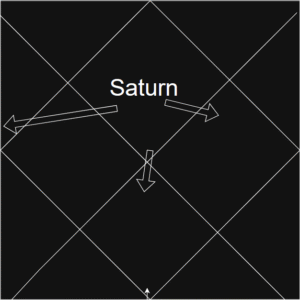

Saturn’s Unique Aspects in Vedic Astrology:
Unlike most planets that aspect only the 7th house from their position, Saturn has three powerful aspects:
3rd house
7th house (common to all planets)
10th house.
Saturn has a “heavy gaze” and its special aspects carry karmic weight. Parashara highlights these aspects as central to how Saturn delivers results in a chart.
3rd Aspect: Linked to courage, communication, and hard efforts. Saturn’s influence here can make a person cautious or reserved and instill discipline in self-expression. Its the most intense gaze of Saturn.
7th Aspect: Impacts partnerships and marriage. Saturn may delay relationships or add seriousness and responsibility in them. It teaches you to balance the things represented by the house it aspect with its 7th aspect.
10th Aspect: Related to karma and career. This is Saturn’s most powerful aspect—it shapes one’s work ethic, responsibility, and long-term achievements.
If Saturn is in the 1st house (Lagna), it will:
Aspect the 3rd house — shaping communication and courage
Aspect the 7th house — influencing relationships
Aspect the 10th house — affecting career and public karma
Such a placement makes Saturn a central karmic influence in one’s personal evolution.
Saturn’s aspects act like a silent teacher — tough at first, wise in the end.
According to the Skanda Purana, Surya’s wife Sandhya could not bear the intense heat of the Sun and created her shadow form Chhaya to serve in her place. From Chhaya, Shani was born — an embodiment of discipline, austerity, and karmic justice.
“Chhaya gave birth to Shani, whose gaze was so powerful that it scorched even the Sun.”
This part of the story emphasizes how Shani’s drishti (aspect) is heavy and intense — consistent with his astrological influence.
When Shani was born, Surya doubted his paternity due to Shani’s dark complexion and aura of detachment. He treated the boy with disdain and coldness, preferring his other son.
Shani, born with the energy of tapas (austerity) and justice, deeply resented this unjust treatment. As a result, the relationship between the Sun and Saturn became strained.
In astrology, this is reflected in the fact that:
Sun and Saturn are mutual enemies (parama shatru).
When placed together in a chart, they often cause ego clashes, conflicts with authority, or a difficult father-child relationship.
Saturn’s cold, karmic energy contrasts with the Sun’s hot, egoic brilliance.
Shani’s gaze (drishti) is known to delay, restrict, and test. Even the powerful Sun was not immune to his karmic sight.
Eventually, with the intervention of sages, Surya realized Shani’s divine purpose — to uphold dharma (righteousness) through karmic justice. The father and son reconciled.
This ending teaches that while Saturn’s energy may seem harsh, it is ultimately meant to purify and mature the soul. Even the Sun must bow to karma.
